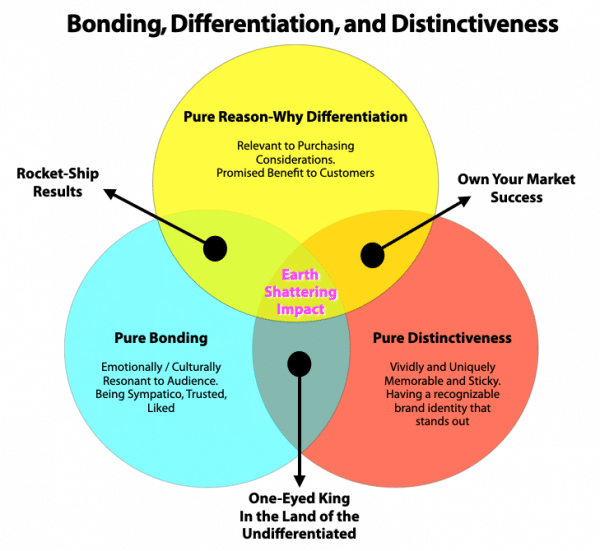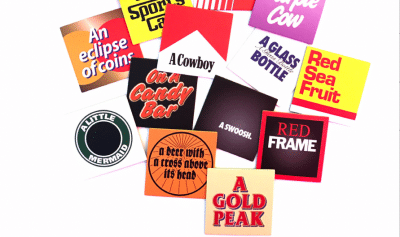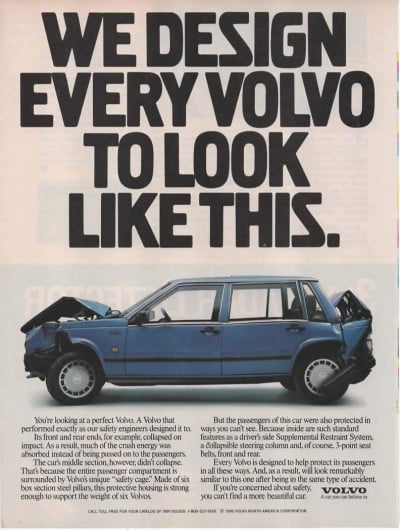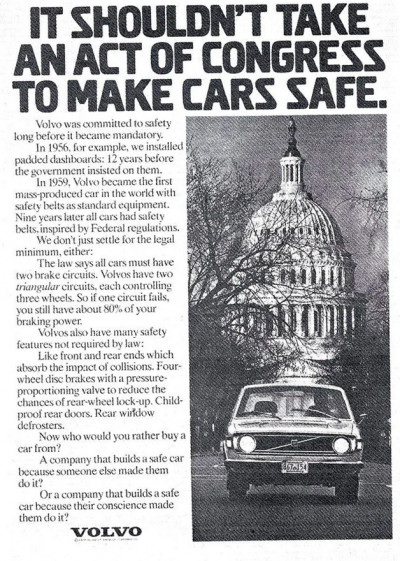
Having the right ingredients matters, for sure.
But even if you’ve got all the right stuff, you’ll get lackluster results if you don’t combine them properly and deploy them in the right order.
A great chef can take the same ingredients and make magic from what a lesser cook turns into gruel.
That’s as true for ad campaigns as cooking.
So today I’ll tell you the right ingredients, and in Part 2 I’ll tell you the right way to sequence those ingredients for maximum results.
As the chart shows, the right stuff comes down to three things:

1) Brand Codes / Distinctive Brand Assets
This means looking, sounding, and feeling like a unique company that stands out as distinctively YOU within a crowded field.
 Note that distinctiveness lives and breathes through sensing and feeling, not thinking.
Note that distinctiveness lives and breathes through sensing and feeling, not thinking.
You look, sound, and feel distinct, but those sensory distinctions don’t necessarily point to or connect with any logical differentiations.
This isn’t about (logically) showing how you’re better than the competition.
This is about showing up as distinctively you when people see or hear your ads, packaging, store, trucks, uniforms, etc.
It’s also a strategy for creating strong sensory associations tied to your brand.
For example, John Deere has their distinctive green color and their distinctive yellow deer logo.
That doesn’t make their tractors better. It just makes them distinctively unique — you can always tell that a tractor is a John Deere, even while driving past one at 50 mph.
2) Brand Differentiation
 Unlike Brand Distinctiveness, Differentiation IS logical and directly comparative.
Unlike Brand Distinctiveness, Differentiation IS logical and directly comparative.
Differentiators are the realm of the classic Unique Selling Proposition.
Or the differentiating factor was logical and unique, at least at one time.
For example, Volvos may or may not have any safety tech unique to them at this point (I haven’t checked).
But at one time they certainly did. And they used them as differentiating factors:
- Crush zones in the hood
- Roll cages around the passenger compartment
- Side beams reinforcements in the doors
- Three-point safety harnesses, even in the back
- Air bag, to include side airbags.
- Anti-lock brakes
- Fancy anti-whiplash seats up front
If safety was your top concern, the Volvo brand stood out as a top contender.
It’s what differentiated them from, say, Chevy.
At least it did, back in the day.
That doesn’t mean you shouldn’t seek to have them and be the first to claim them, as there is immense value in being uniquely KNOWN for features, benefits, and offers that may not be totally unique to you.
Traditionally, this has been understood as a preemptive claim, and there’s no better illustration of it than this scene from Mad Men:
But the short-lifespan of honest differentiators does mean that you can’t lay the entire foundation of your brand on this one item.
More importantly, it points to HOW you ought to present these differentiators when you have them, which brings up our next ingredient…
3) Bonding
This is why having a spokesperson or spokes-critter for the brand is so important in facilitating bonding — people can’t bond very well with a faceless, personality-less corporation.
They can and do bond with identifiable characters — especially if they’re willing to disclose emotional details and backstories about themselves.
Because the important truth about bonding is that some connection always beats no connection.
If you’ve bonded with a prospect even a little bit — and no other brand has — then you’ll likely win the sale.
Sure, a compelling offer might over-ride that bond — e.g., I may love my local wood-fired pizza place, but if I need it delivered, I’m calling Domino’s — and that’s why you want your brand to have all three ingredients: distinctiveness, differentiation, and bonding.
But in a relatively undifferentiated competitive landscape, bonding and distinctiveness can absolutely carry the day.
Think about it: bonding doesn’t require you to believe that your friend is the very best at anything.
You don’t bond over skillsets and offers. You bond over values and life experiences.
That’s why bonding should become a bedrock of your branding campaign — unlike differentiation, it can’t be taken away.
It’s also why it’s smart to present differentiators as a manifestation of your core values in action, rather than as straight offers or reason-why appeals.
For example, when other companies started offering some of Volvo’s safety features, they ran this brilliant bonding ad:

Now You’ve Got The Ingredients List, Stay Tuned for Sequencing
Alright, that’s it for the ingredients. Tune in next week for how to sequence these ingredients.
And if you’d like, you can read more of my articles in the meantime by clicking this link.
- Are You Paying for Too Much for the Wrong Keywords? - July 15, 2024
- Dominate Your Market Like Rolex — 4 Powerful Branding Lessons - July 3, 2024
- Military-Grade Persuasion for Your Branding - June 25, 2024
